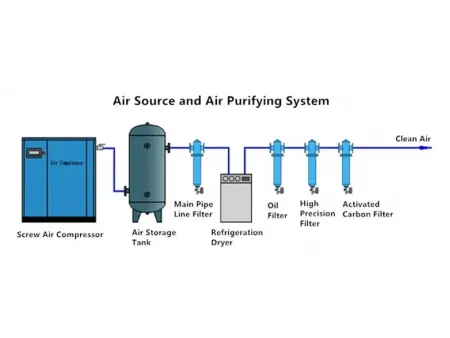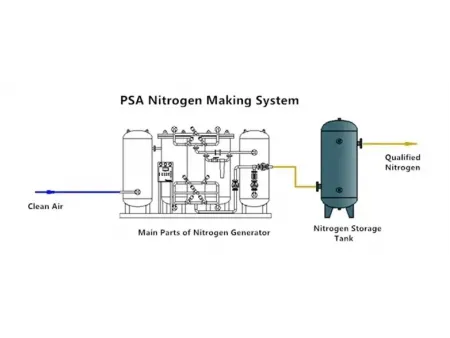PSA Nitrogen Generators
- Nitrogen capacity: 3-5000Nm³/h (standard conditions)
- Nitrogen purity: 90%-99.9995% (oxygen-free nitrogen)
- Nitrogen pressure: 0.1-0.8Mpa (stable and adjustable pressure)
- Nitrogen dew point: -40°C to -70°C (atmospheric pressure)
- Can be used in food freshness preservation in food processing plants, nitrogen needs in research laboratories, transport and storage of oil and gas, etc.;
- Can be used in nitrogen sealing, nitrogen protection, material transport and distribution in the production of the chemical and pharmaceutical industries, preventing oxygen contamination of raw materials and production processes;
- Can be used in lead-free reflow soldering, wave soldering, blowing and encapsulation, high-precision chip sealing, PCB baking and so on in electronic industry;
- Can be used in steelmaking converter sealing, steel annealing, vacuum quenching and other nitrogen-based atmosphere heat treatment in metallurgical heat treatment industry;
- Can be used as auxiliary gas in the laser cutting industry for cooling, as well as preventing oxidation
PSA nitrogen generation is a technology to separate nitrogen from air by the adsorption ability of carbon molecular sieve under pressure by air compressor. After the air is compressed and purified (removing the oil, water and dust, etc.) before transferring into the absorption tower filled with carbon molecular sieves (CMS), the oxygen molecule will be adsorbed by carbon molecular sieve, while nitrogen molecules are too large so that they will not be adsorbed. Those nitrogen molecules will pass through the tower into the nitrogen buffer tank, while oxygen molecules remain in the CMS. The adsorption process is performed at certain pressure, after that, the atmospheric pressure will be resumed again, and the adsorbed oxygen molecules will escape from CMS, passing the bottom of the tower through the exhaust silencing muffler into the air, and the CMS is available to be reused. Usually PSA nitrogen generator adopts double adsorption towers in parallel, they will be used alternatively for the adsorption and collection of the nitrogen under different pressure, continuously supporting the separation of oxygen and nitrogen and producing nitrogen. The above process will be automatically controlled by PLC system.



